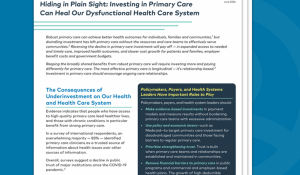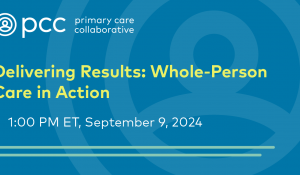You are looking at an archived version of our site. Please visit thepcc.org for a fresh, new experience!
January Lunch and Learn Discussion
During the meeting, Dr. David Grande, Associate Professor at the University of Pennsylvania School of Medicine, and Dr. Sonal Patil, Clinician-Investigator at the Cleveland Clinic Community Care Institute, presented on these two articles and participated in a discussion with the audience about their policy and practice implications:
- Patil SJ, Wareg NK, Hodges KL, Smith JB, Kaiser MS, LeFevre ML. Home blood pressure monitoring in cases of clinical uncertainty to differentiate appropriate inaction from therapeutic inertia. Ann Fam Med. 2020;18(1):50-58. doi: https://doi.org/10.1370/afm.2491
- Kangovi S, Mitra N, Norton L, et al. Effect of Community Health Worker Support on Clinical Outcomes of Low-Income Patients Across Primary Care Facilities: A Randomized Clinical Trial. JAMA Intern Med. 2018;178(12):1635-1643. doi:10.1001/jamainternmed.2018.4630
In addition, Ashlee Harris, a community health worker at the Penn Center for Community Health Workers, reflected on the important role of community health workers and their ability to empathize and meet patients where they are.
Summary of Discussion:
Effect of Community Health Worker Support on Clinical Outcomes of Low-Income Patients Across Primary Care Facilities: A Randomized Clinical Trial
- Community health workers provide goal-setting, tailored support, coaching, social support, and care navigation. Community health workers meet people where they are. They get to know their patients’ life story, identify their patients’ needs, and co-create achievable goals.
- Overall, the study observed improvements in patients’ perceptions of the quality of the healthcare they were receiving and saw large reductions in acute care utilization.
- Patients who received tailored support from a community health worker (CHW) were much more likely to rank the primary care they were receiving at the highest quality level than those who did not receive community health worker support.
- Patients receiving support from a CHW spent 155 days in the hospital in total compared to 345 days in the group that did not receive CHW support, a reduction of 69%.
- Additional research has also demonstrated a favorable return on investment for Medicaid payers in this model, generally returning well over $2 for every dollar invested.
- Training and Certification Resources: We should ensure professionals have the appropriate skills and competencies to engage with patients but also not allow these types of certification training programs to become barriers to entry for people trying to join the profession.
- Michigan Community Health Worker Training
- Indiana Community Health Worker Association
- Ohio Board of Nursing, Community Health Worker Certification
- Massachusetts Board of Certification of Community Health Workers
- Connecticut State Licensing of Community Health Workers
- Developing Sustainable Community Health Worker Career Paths
- Legislation expanding funding for community health worker services is introduced
Home blood pressure monitoring in cases of clinical uncertainty to differentiate appropriate inaction from therapeutic inertia
- Physicians and patients are reluctant to intensify treatment when they are uncertain if that single elevated platelet blood pressure truly reflects the patient's hypertension control state. Clinic blood pressures are known to be least accurate and repeated outside-the-office blood pressure measurements accurately reflect hypertension control state.
- When physicians and patients are uncertain about identifying treatments in the presence of an elevated clinic blood pressure reading, documenting average home blood pressures improves hypertension control rates and clinical decision-making.
- Findings: Two-thirds of patients with clinic blood pressure in an uncontrolled hypertension range had controlled hypertension with average home blood pressure measurements. Overall, average home blood pressure documentation improved hypertension control rates.
- Policy Recommendations:
- Average home blood pressures should be used for estimating hypertension control rates and for clinical decision-making.
- Loaning or prescribing valid home BP monitors is crucial. Non-validated home blood pressure monitors are common. Only about 20% of the 3,000 commercially available blood pressure monitors are validated.
- The American Medical Association (AMA) has a list of validated blood pressure monitors.
- Insurance coverage of valid home blood pressure machines may reduce disparities because 83% of patients who did not own blood pressure monitors said they would buy one if insurance covered it.
Community Health Worker, Penn Center for Community Health Workers
Ms. Ashlee Harris is a Community Health Worker at the Penn Center for Community Health Workers. Throughout her 4 years at the Center, she has provided social and emotional support to many disadvantaged patients in the Philadelphia region, including individuals with Sickle Cell Disease. Ms. Harris advocated for a patient to develop and facilitate her own Sickle Cell support group. This group educates, supports, and empowers patients and their families. read more
Associate Professor, University of Pennsylvania School of Medicine
David Grande, MD, MPA is an Associate Professor of Medicine at the University of Pennsylvania School of Medicine and Director of Policy at the Leonard Davis Institute of Health Economics. His research focuses on health care for vulnerable populations with an emphasis on identifying and overcoming barriers to care. He also studies ethical issues related to marketing in health care and digital health information privacy.
Dr. Grande received his MD at the Ohio State University and trained in internal medicine at the Hospital of the University of Pennsylvania. He completed a Masters in Public Affairs (MPA) at the Woodrow Wilson School at Princeton University and was a Robert Wood Johnson Health & Society Scholar at the University of Pennsylvania.
read more
Chief Health Equity Officer/Deputy Chief Health Officer , Merative (formerly IBM Watson Health)
In her role at IBM Watson Health, Dr. Dankwa-Mullan is responsible for the global strategy for driving building clinical evidence for Watson Health solutions. This is accomplished through evaluation research, real-world evidence studies and implementation studies to support evidence-based practices to transform health care. She works with multidisciplinary teams at the interface of big data, cognitive computing and machine learning technology to inform healthcare delivery and clinical decision-making.
read more
Jack Westfall is a family doctor in Washington, D.C. He completed his MD and MPH at the University of Kansas School of Medicine, an internship in hospital medicine in Wichita, Kansas, and his Family Medicine Residency at the University of Colorado Rose Family Medicine Program.
After joining the faculty at the University of Colorado Department of Family Medicine, Dr. Westfall started the High Plains Research Network, a geographic community and practice-based research network in rural and frontier Colorado. He practiced family medicine in several rural communities including Limon, Ft. Morgan, and his hometown of Yuma, Colorado. read more
Clinician-Investigator, Cleveland Clinic Community Care Institute
Dr. Sonal Patil is a Clinician-Investigator in the Wellness and Preventive Medicine Department in the Cleveland Clinic Community Care Institute. After completing her residency at the Emory Family Medicine Residency program, Dr. Patil worked as a full-time clinician at Kaiser Permanente in Georgia and East Boston Neighborhood Health Center (EBNHC). Dr. Patil got interested in health services research after noticing differing health outcomes in patients by what occurred in between clinic visits. Dr. Patil completed post-graduate coursework in Principles and Practice of Clinical Research (PPCR), then offered through Harvard Medical School, while working as a staff physician at EBNHC. Dr. Patil transitioned to a clinician-investigator career after receiving an MSPH degree from University of Missouri. Before joining Cleveland Clinic, Dr. read more
What's New
June 12, 2024









